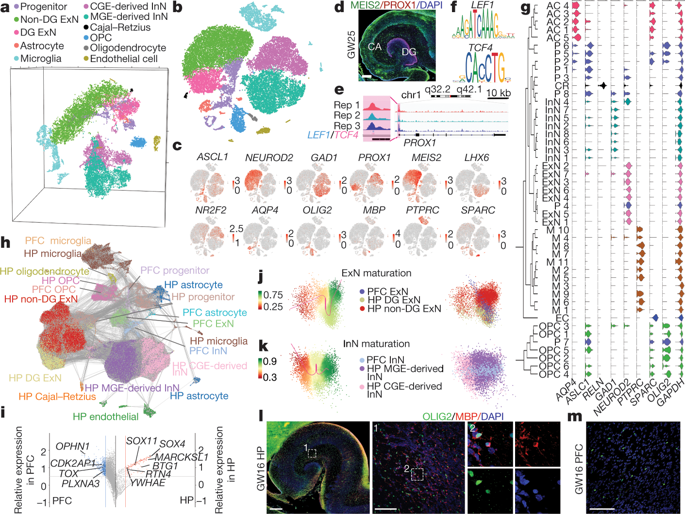Nature ( IF 50.5 ) Pub Date : 2020-01-15 , DOI: 10.1038/s41586-019-1917-5 Suijuan Zhong 1 , Wenyu Ding 2 , Le Sun 1, 3, 4 , Yufeng Lu 1, 4 , Hao Dong 1, 4 , Xiaoying Fan 5 , Zeyuan Liu 1, 4 , Ruiguo Chen 1, 4 , Shu Zhang 5 , Qiang Ma 1, 4 , Fuchou Tang 5, 6, 7 , Qian Wu 2, 8 , Xiaoqun Wang 1, 3, 4, 9

|
The hippocampus is an important part of the limbic system in the human brain that has essential roles in spatial navigation and the consolidation of information from short-term memory to long-term memory1,2. Here we use single-cell RNA sequencing and assay for transposase-accessible chromatin using sequencing (ATAC–seq) analysis to illustrate the cell types, cell linage, molecular features and transcriptional regulation of the developing human hippocampus. Using the transcriptomes of 30,416 cells from the human hippocampus at gestational weeks 16–27, we identify 47 cell subtypes and their developmental trajectories. We also identify the migrating paths and cell lineages of PAX6+ and HOPX+ hippocampal progenitors, and regional markers of CA1, CA3 and dentate gyrus neurons. Multiomic data have uncovered transcriptional regulatory networks of the dentate gyrus marker PROX1. We also illustrate spatially specific gene expression in the developing human prefrontal cortex and hippocampus. The molecular features of the human hippocampus at gestational weeks 16–20 are similar to those of the mouse at postnatal days 0–5 and reveal gene expression differences between the two species. Transient expression of the primate-specific gene NBPF1 leads to a marked increase in PROX1+ cells in the mouse hippocampus. These data provides a blueprint for understanding human hippocampal development and a tool for investigating related diseases.
中文翻译:

解码人类海马体的发育
海马体是人脑边缘系统的重要组成部分,在空间导航和将信息从短期记忆整合到长期记忆1,2中具有重要作用。在这里,我们使用单细胞 RNA 测序和使用测序 (ATAC-seq) 分析对转座酶可及的染色质进行测定,以说明发育中的人类海马的细胞类型、细胞谱系、分子特征和转录调控。使用妊娠第 16-27 周人类海马体的 30,416 个细胞的转录组,我们确定了 47 种细胞亚型及其发育轨迹。我们还确定了 PAX6 +和 HOPX +的迁移路径和细胞谱系海马祖细胞,以及 CA1、CA3 和齿状回神经元的区域标志物。多组学数据揭示了齿状回标记 PROX1 的转录调控网络。我们还说明了发育中的人类前额叶皮层和海马体的空间特异性基因表达。人类海马在妊娠第 16-20 周的分子特征与小鼠在出生后第 0-5 天的相似,揭示了两个物种之间的基因表达差异。灵长类动物特异性基因NBPF1的瞬时表达导致小鼠海马中 PROX1 +细胞的显着增加。这些数据为了解人类海马发育提供了蓝图,也为调查相关疾病提供了工具。











































 京公网安备 11010802027423号
京公网安备 11010802027423号